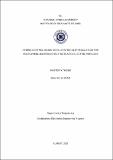DSpace Repository
HYBRID CONTROL-BASED ACCELERATION SLIP REGULATION FOR FOUR-WHEEL-INDEPENDENTLY-ACTUATED ELECTRIC VEHICLES
JavaScript is disabled for your browser. Some features of this site may not work without it.
| dc.contributor.author | SHAH, Sehar Imran
|
|
| dc.date.accessioned | 2023-09-12T11:31:15Z | |
| dc.date.available | 2023-09-12T11:31:15Z | |
| dc.date.issued | 2022 | |
| dc.identifier.uri | http://hdl.handle.net/11547/10279 | |
| dc.description.abstract | This report presents a speed increase slip guideline (ASR) framework for four-wheel drive (4WD) electric vehicles, which are driven by the front and back axles at the same time. The ASR control technique incorporates three control modes: normal appropriation of between hub force, ideal circulation of between pivot force and free control of ideal slip rate, individually, which are planned considering the force versatile standard of between hub differential and sliding mode control hypothesis. Besides, to precisely depict the longitudinal tire force trademark, a slip rate estimation recipe as a state condition was utilized for tackling the mathematical issue presented by the conventional way. A reproduction was done with the MATLAB/Simulink programming. The recreation results show that the proposed ASR framework can completely utilize the street erosion condition, hinder the drive-wheels from slipping, and further develop the vehicle longitudinal driving soundness. Force vectoring in electric ground vehicles (EGV) with exclusively impelled in-wheel engines (IAIWM) presents the chance to carry out a wide scope of control techniques for controlling vehicle yaw rate to further develop vehicle security and execution. The utilization of IAIWMs considers elective vehicle format setups which already would have been inaccessible to customary gas-powered motor vehicles. The utilization of more elevated level control structures to circulate force among the two-front wheel-drive, back tire drive or four wheel-drive in-wheel engines of an electric ground vehicle has introduced the amazing chance to plan qualities of electric ground vehicles through dynamic control of force trains. Beforehand in gas powered motor vehicles, these attributes have been by implication tuned by means of normal skeleton boundaries. The utilization of present-day parts, for example, in-wheel engines in electric ground vehicles likewise gives extra advantages, for example, exact force age, quick engine reaction and the ability to create forward and switch force as well as regenerative slowing down to further develop energy proficiency and empowering the assessment or estimation of helpful criticism data. This criticism data can be applied to coordinate yaw-second control (DYC) systems which can be utilized to further develop vehicle execution. The utilization of these new vehicle designs can consider differential force result to the left- and right hand side of vehicles, creating a yaw second, and thus straightforwardly influencing the yaw pace of the vehicle in a training known as immediate yaw-second control. Notwithstanding the potential electric ground vehicles have for unrivaled vehicle strength and execution, they are likewise a suitable answer for the natural worries relating to ship needs and meeting lower outflows targets. In this proposal the most common way of switching a gas-powered motor vehicle over completely to a completely electric vehicle with IAIWM will be introduced. The reenactment stage introduced in this postulation is likewise expected for use as device for examination on future ventures relating to the exploratory electric vehicle. The following goal of this postulation is to lay out the estimation and assessment procedures accessible and how they could be executed through reasonable equipment to quantify and keep the pertinent presentation marks of vehicle elements corresponding to a DYC technique. At last, this proposal plans to demonstrate the exactness of the reenactment stage created utilizing exploratory information obtained from sensors carried out on the trial vehicle. The reenactment stage is approved tentatively as an exact portrayal of the trial framework and its exhibition regarding sensible vehicle elements. Trial information is utilized to reproduce genuine driving moves in the reproduction stage and confirm its presentation by contrasting outcomes. | tr_TR |
| dc.publisher | ISTANBUL AYDIN UNIVERSITY INSTITUTE OF SOCIAL SCIENCES | tr_TR |
| dc.title | HYBRID CONTROL-BASED ACCELERATION SLIP REGULATION FOR FOUR-WHEEL-INDEPENDENTLY-ACTUATED ELECTRIC VEHICLES | tr_TR |
| dc.type | Thesis | tr_TR |
Files in this item
This item appears in the following Collection(s)
-
Tezler -- Thesis [3536]
